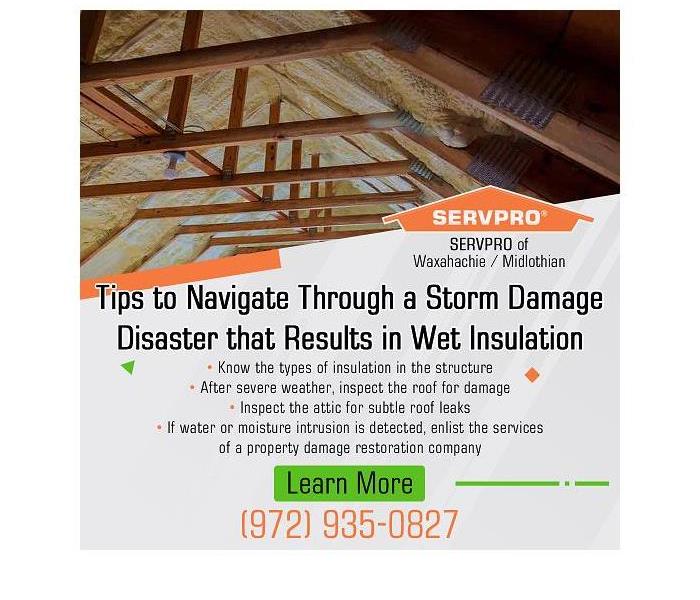Dealing With Water Damaged Insulation After Storm Damage
7/1/2021 (Permalink)
Blog Summary: SERVPRO of Waxahachie/Midlothian explains how to deal with wet insulation from a roof leak caused by storm damage.
Storm-related water damage in Midlothian, TX, can often strike without warning. When severe weather leads to a water damage disaster, the SERVPRO professionals can quickly restore the damaged property. The restoration experts specialize in residential, commercial, and large-scale disaster cleanup and restoration.
How to deal with wet insulation resulting from storm damage in Midlothian, TX
If insulation is exposed to water and moisture from a leak or roof damage, it loses its insulating capacity. The same wet insulation also becomes a health hazard. If the water intrusion is allowed to continue, the insulation can retain enough water to collapse ceilings and weaken the structural integrity of the home. In most cases, when a roof leak saturates insulation, the insulation almost always requires replacement.
Wet insulation harms the roof, the building, and its occupants
Attic insulation is situated immediately below the roof. A leak permits water seepage through the roof’s outer membrane. The saturated insulation has the potential to cause the roof to deteriorate on many fronts.
- Water-saturated insulation puts a heavy burden on the entire structure. Over a long duration, the constant weight causes warping and other structural damage.
- Moisture trapped in insulation gradually degrades the entire roofing system. The damage will not stop at the decking but will spread to the rest of the structure, compromising the integrity of the entire building.
- Long-term exposure to moisture causes roofing fasteners to corrode. Steel studs and wall ties begin to rust, crack and break. The resulting loss of structural integrity reduces wind-uplift ratings in the roof. In severe weather, the results could be catastrophic.
- Wet insulation is a prime breeding ground for mold and bacteria, which can cause health effects.
Wet insulation negatively impacts R-value and the energy efficiency of a home or business
Dry insulation functionally repels energy. Hot air stays outside. Cool air stays inside, or vice versa. Wet insulation conducts energy. In other words, the wet insulation fails to perform its intended task. Heating costs will reflect the loss of efficiency. Summer cooling costs will also reflect the price impact of the lost efficiency.
Water-logged insulation will have a diminished “R-Value.” The “R-value” gauges thermal resistance. Insulating materials with a higher R-Value are more effective at resisting heat transfer. Water-saturated insulation forfeits up to forty percent of its R-Value. The increase in energy bills can be dramatic and financially painful for the bottom line.
How do different types of insulation respond to water intrusion?
Insulation types vary widely in cost, application, efficiency, and response to water saturation.
- Wood fiber insulation, for example, can soak up surrounding moisture and compromise a wide area of a roof.
- Isocyanurate, a rigid thermal foam insulation, can be dried out and put back in place.
- Open-celled foam insulation, which is relatively economical, contains tiny cells that are not entirely closed. This insulation contains minimal trace chemicals and performs well as an air barrier. Best for interior applications, it is often found in walls due to its sound-reduction qualities. Because of its sponge-like texture and absorption qualities, open-celled foam insulation is inappropriate for exterior applications.
- Closed-cell foam insulation has a more compact structure that provides an excellent barrier to both air and moisture. Roofers favor this type of insulation because it withstands the elements without compromising R-value.
What if storm damage leads to water-saturated insulation?
A water intrusion incident can create a nightmare for the homeowner or business if certain types of insulation are involved. These tips will help property owners navigate their way through a storm damage disaster that results in wet insulation.
- Know the types of insulation in the structure, how each type responds to exposure to moisture, and whether or not the insulation can be restored.
- After severe weather, inspect the roof for damage from high winds, hail, debris, and perforations from fallen limbs or trees.
- Inspect the attic for subtle roof leaks that may have introduced water and moisture into the attic insulation.
- If water or moisture intrusion is detected, enlist the services of a property damage restoration company with the knowledge, expertise, and equipment to mitigate the water intrusion and appropriately manage the wet insulation.
Hidden water and moisture that is left untreated can slowly undermine the structural integrity of a home or building and lead to a mold infestation that can put residents, employees, and customers at risk for health effects. Each roof has its own set of unique insulation requirements. Among all these variables, one thing is certain when a roof leak is discovered: wet insulation must be addressed as soon as possible.
For more information about water damage restoration services by SERVPRO of Waxahachie/Midlothian, contact the water damage restoration company by phone at (972) 935-0827 or email acarey@SERVPRO10932.com.



 24/7 Emergency Service
24/7 Emergency Service
